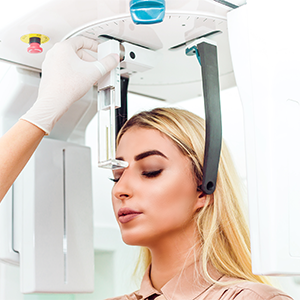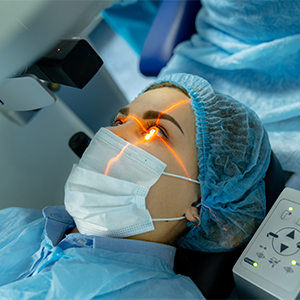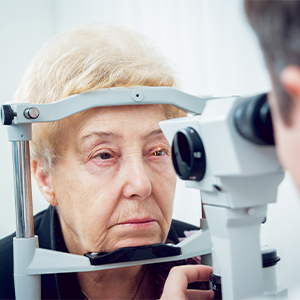Laser Eye Surgery
Lasik
 The laser eye surgery procedure known as Lasik has a very high rate of success. The first step in the procedure is to numb the eye with anesthetic eye drops. The corneal layer is then removed using a unique instrument called a microkeratome. It is known as corneal flap formation.
The laser eye surgery procedure known as Lasik has a very high rate of success. The first step in the procedure is to numb the eye with anesthetic eye drops. The corneal layer is then removed using a unique instrument called a microkeratome. It is known as corneal flap formation.
Carefully fold the corneal flap backwards away from the spot where the laser will be used. The excimer laser sends laser rays (beams) to the tissue underneath the excised area.
Myopia and hyperopia can be corrected with laser eye surgery using the Lasik technique. Throughout the laser vision correction, the patient doesn’t experience any pain. Within three to five days, the patient has a good quality of eyesight.
The optometrist will provide a sedative and a particular numbing drop to your eyes throughout the process, after which he will use a device to maintain your eyelid open. A tiny bit of corneal tissue is removed by each laser pulse. By focusing on a bright object, you can keep your eye still while the laser reshapes your cornea. Surgery for LASIK only takes 30 minutes.
After the procedure, you should get plenty of rest, use the eye drops that your doctor ordered to stop inflammation and infection, and use artificial tears to help your eyes heal and stay moisturized. It’s typical for dry eyes to develop following LASIK. It’s crucial to wash your face without touching your eyes following surgery and to use sunglasses while going outside during the day to avoid scarring brought on by strong sunlight. Eye protection is strongly advised when sleeping to prevent touching the eyes.
No Touch Laser
 No Touch Laser Surgery, also known as transPRK (transepithelial PRK) and touch free laser surgery, is a refractive treatment that uses a carefully regulated excimer laser to remove the corneal stroma and epithelium in a single step without the use of alcohol as in traditional PRK. The surgeon uses alcohol to quickly remove the corneal epithelium.
No Touch Laser Surgery, also known as transPRK (transepithelial PRK) and touch free laser surgery, is a refractive treatment that uses a carefully regulated excimer laser to remove the corneal stroma and epithelium in a single step without the use of alcohol as in traditional PRK. The surgeon uses alcohol to quickly remove the corneal epithelium.
The following are some benefits of the No Touch Laser:
- No sharp instrument or gadget is used to operate on the eye during the laser surgery.
- Both eyes’ laser vision correction can be finished in a single session.
- Your eyes won’t be covered after the laser vision correction, and you’ll be sent home with safety eyewear.
- The laser vision correction is used to treat individuals with myopia, hyperopia, and astigmatism. It can also be used on people with thin corneal structures.
- None of the corneal layers are removed.
- Since there is no contact with the eyes at the conclusion of the procedure, the likelihood of developing dry eye syndrome is quite low.
- Patients with high refractive errors can also use laser vision correction, according on the findings of a corneal topography exam.
Cataract
 When a cataract develops in the eye, cataract surgery is necessary to replace the lens. This is when the natural lens has clouded over and lost its clarity. Driving may become challenging due to the cataract’s impaired vision and lack of contrast.
When a cataract develops in the eye, cataract surgery is necessary to replace the lens. This is when the natural lens has clouded over and lost its clarity. Driving may become challenging due to the cataract’s impaired vision and lack of contrast.
Despite the fact that cataracts can develop at any age, the normal aging process of the eye makes them more prevalent in persons over 60. Cataracts can also be inherited or brought on by conditions like diabetes or prior eye injuries.
Cataracts typically get bigger if untreated, obscuring vision more over time, and eventually resulting in blindness.
The treatment starts with eyedrops to enlarge your pupil and local anesthetic, then the clouded lens is removed, either with or without the implantation of an artificial lens. In the original cataract stage, the lens is broken up and removed using an ultrasound probe; however, subsequent cataracts may develop and are often treated with a painless (YAG) laser capsulotomy.
You may encounter any or all of the following in the first few days following surgery:
Your pupil will stay dilated for up to 48 hours after surgery, which will produce blurry vision.
Sensitivity to light; once more, your dilated pupils are to blame for this.
Haloes around the light; this usually dissipates quickly
A scratchy sensation, like to getting a sand grain caught in your eye. No extreme pain should be experienced.
A slight pain in your eye
Your eye may be pinkish in color or have some small, localized bruising that is bright red, which is more common if you are taking aspirin or warfarin.
After about two days, your pupil will revert to normal size, which will significantly enhance your overall eyesight.
Visits to your optometrist are required to monitor your recovery. Avoid rubbing or poking your eye. On the day of surgery, for a few days later, and while you sleep throughout the recovery period, you must wear an eye patch or protective shield. To stop infection, soothe inflammation, and manage eye pressure, eyedrops or other drugs are also necessary. After a few days, the majority of the soreness should disappear. Normally, it takes eight weeks for full recovery.
Relex Smile
 ReLEx® SMILE is a cutting-edge method of keyhole laser eye surgery that can improve vision in patients with more severe short-sightedness. Small Incision Lenticule Extraction, or SMILE, is a minimally invasive bladeless surgery. People with or without astigmatism can benefit from SMILE eye surgery, which is an excellent alternative to the more well-known LASIK and LASEK procedures.
ReLEx® SMILE is a cutting-edge method of keyhole laser eye surgery that can improve vision in patients with more severe short-sightedness. Small Incision Lenticule Extraction, or SMILE, is a minimally invasive bladeless surgery. People with or without astigmatism can benefit from SMILE eye surgery, which is an excellent alternative to the more well-known LASIK and LASEK procedures.
What is the process of SMILE eye surgery?
SMILE laser eye surgery is a cutting-edge laser procedure that makes use of a modern Carl Zeiss VisuMax laser. The steps are as follows:
To ensure that the procedure is painless, your surgeon will first numb the eye with anesthetic eye drops.
The Carl Zeiss VisuMax laser is then used to precisely position a number of pulses on the center of the cornea.
The laser’s pulses then produce little bubbles that are no larger than a human hair in diameter. The tissue that needs to be cut out is defined by these bubbles.
The surgeon can draw out tissue by using the laser to make a tiny connecting tunnel, altering the cornea’s structure to improve your vision.
For both eyes, the entire process takes less than 15 minutes, with the laser only being used for a tiny fraction of that time.
